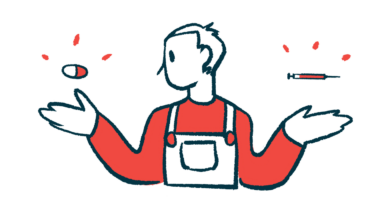Standardized assessments of GAA, glycogen needed in Pompe: Study
Measures would help to quantify disease severity, treatment effectiveness

While the activity of the acid alpha-glucosidase (GAA) enzyme and glycogen buildup are hallmarks of Pompe disease, the lack of standardized assessments to quantify both parameters hampers evaluations of disease severity and treatment efficacy, according to a review study.
All current methods, however, do confirm lower GAA activity and heightened glycogen levels in infantile-onset Pompe disease (IOPD) patients relative to those with late-onset disease (LOPD).
Altogether, the noted variations in methodologies “demonstrate the need for globally standardized methods for measuring muscle GAA activity and glycogen content, to allow more accurate assessment of … disease severity and better define the efficacy parameters of a therapeutic intervention,” the researchers wrote.
The study, “Acid α-glucosidase (GAA) activity and glycogen content in muscle biopsy specimens of patients with Pompe disease: A systematic review,” was published in the journal Molecular Genetics and Metabolism Reports.
Researchers set out to gather evidence from wide range of studies
Pompe disease is caused by low to no levels of working acid alpha-glucosidase, or GAA for short — an enzyme that breaks down glycogen, a large sugar molecule — due to mutations in the GAA gene. When glycogen is not broken down, it can build up to toxic levels in tissues, particularly muscles.
This causes a range of symptoms, from muscle weakness to difficulty breathing, that can manifest in the first year of life for patients with IOPD or later in life for those with LOPD.
Measuring GAA activity and the levels of glycogen buildup in skeletal muscle — those used for movement — helps assess disease severity, guide treatment choices, and track how patients respond to therapy.
However, the distribution of GAA and glycogen both in the muscles of healthy people and of Pompe patients remains largely unknown. Also, there are no standardized assessments, or a universal assay, for measuring GAA activity.
In this study, researchers in Germany and Italy, along with scientists at M6P Therapeutics and Astellas Pharma in the U.S., conducted a systematic review. Their goal: gather and summarize evidence from studies in skeletal muscle biopsies from Pompe disease patients and healthy people. The study was funded by Astellas Gene Therapies.
A review of online databases yielded 24 studies, published from 1965 to 2018, to be included in the final analysis. These studies involved greater than 100 muscle biopsies from more than 100 Pompe disease patients.
With no standardized assessments, multiple methods used as measures
The sugars used as a substrate in assays to measure GAA activity included MUalphaG, glycogen, and maltose/MUalphaG. Each was used in three or more studies
GAA activity in healthy individuals was reported in eight of 14 studies, and the levels of activity varied substantially with no clear pattern specific to different methodological approaches.
In six studies, GAA activity was assessed using a measure called nmol, for nanomol per minute per gram of protein as units. Again, no obvious pattern differentiated the methods used.
Three studies measured GAA activity looking at the amount of glucose (sugar); in two, maltose (formed by two molecules of glucose) was the substrate, whereas glycogen was the substrate in the other study.
In comparison to GAA activity, glycogen accumulation in muscles was measured by two methods only — percentage of protein or micrograms per milligram (mcg/mg) of protein. In nine studies assessing glycogen in healthy muscle, levels ranged between 0.12% to 18%. In three studies using mcg/mg of protein, levels ranged from 32 to 80.
As expected, GAA activity levels in arm and leg muscles was lower in patients with Pompe disease than in healthy people. GAA activity always was lower in patients with IOPD compared with those with LOPD, regardless of the method used. Specifically, this was seen when MUalphaG was the substrate.
The findings underscore the challenges in the interpretation and comparison of the results across studies because of the substantial methodological variations.
Glycogen abundance in patients also was evaluated using only two methods, similarly to healthy people. As expected, glycogen levels were higher in Pompe patients than in healthy individuals. Among patients, glycogen accumulation was higher in IOPD than in LOPD patients.
“As expected, this analysis provides evidence of the relationship between Pompe disease severity and the levels of GAA enzyme activity and glycogen content in muscle,” the study concluded.
According to the researchers, this review shows a clear need for new standardized assessments for evaluating both Pompe severity and the effectiveness of treatments on disease parameters.
“The findings underscore the challenges in the interpretation and comparison of the results across studies because of the substantial methodological variations,” the team wrote.







